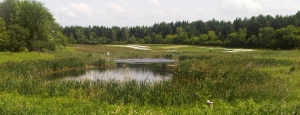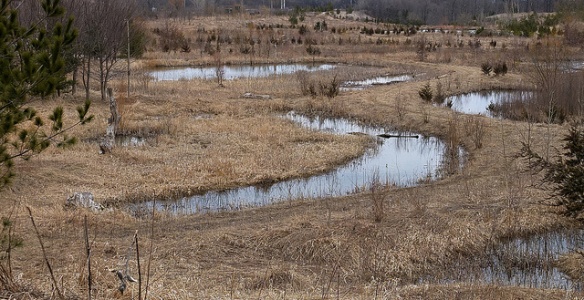Difference between revisions of "Wetlands"
Jenny Hill (talk | contribs) m |
Jenny Hill (talk | contribs) |
||
| Line 25: | Line 25: | ||
|Schematic of a vertical subsurface flow constructed wetland: Water flows through pipes on the subsurface of the ground through the root zone to the ground. | |Schematic of a vertical subsurface flow constructed wetland: Water flows through pipes on the subsurface of the ground through the root zone to the ground. | ||
|- | |- | ||
| − | |||
| − | |||
|style="text-align:left;"|'''Pros''' | |style="text-align:left;"|'''Pros''' | ||
| − | *High levels of | + | |style="text-align:left;"|'''Pros''' |
| − | *DIY possible | + | *Well established technology |
| + | *Low cost | ||
| + | *May be natural looking | ||
| + | *Need little to no gradient | ||
| + | *Provides buffer to discharge | ||
| + | *Good pathogen removal from die off and predation | ||
| + | *Minimal maintenance | ||
| + | *Wide range of plants suitable | ||
| + | *Robust | ||
| + | |style="text-align:left;"|'''Pros''' | ||
| + | *High levels of treatment possible | ||
| + | *DIY possible (to lower cost) | ||
*May be run without power if significant gradient is avaialble | *May be run without power if significant gradient is avaialble | ||
*Can be attractively designed to generate interest in the technology. | *Can be attractively designed to generate interest in the technology. | ||
| Line 35: | Line 44: | ||
*Biologically complex and robust | *Biologically complex and robust | ||
*Failure tends to be gradual | *Failure tends to be gradual | ||
| − | *Will function prior to establishment of | + | *Will function prior to establishment of vegetation |
|- | |- | ||
| | | | ||
|style="text-align:left;"|'''Cons''' | |style="text-align:left;"|'''Cons''' | ||
| + | *Requires more land | ||
| + | |style="text-align:left;"|'''Cons''' | ||
| + | *Requires fall of at least 1.5 m to provide sufficient treatment | ||
| + | *May be high cost | ||
| + | *Sensitive to hydraulic overloading | ||
|- | |- | ||
|Maintenance||Medium to high||Low | |Maintenance||Medium to high||Low | ||
Revision as of 16:01, 1 October 2018
Overview[edit]
Constructed wetlands are similar to SWM ponds in function and design, with the most significant difference being that they are designed to incorporate shallow zones for wetland plants. A facility is normally characterized as a wetland if shallow zones (<0.5 m deep) make up more than 70 % of its volume.
Wetlands are an ideal technology for:
- Text A
- Text B
Planning considerations[edit]
Design[edit]
| Element | Design Objective | Criteria |
|---|---|---|
| Drainage Area | Sustaining vegetation, volumetric turnover | 5 Ha (≥10 Ha preferred) |
| Treatment Volume | Provision of appropriate level of protection (Table 3.2) | See Table 3.2 |
| Active Storage | Detention | Suspended solids settling 24 hrs (12 hrs if in conflict with min. orifice size) |
| Forebay | Pre-treatment |
|
| Length-to-Width Ratio | Maximize flow path and minimize short-circuiting potential |
|
| Permanent pool depth | Vegetation requirements, rapid settling | The average permanent pool depth should range from 150 mm to 300 mm |
| Active storage depth | Storage/flow control, sustaining vegetation | Maximum 1.0 m for storms < 10 year event |
| Side slopes (See also berms) | Safety |
|
| Inlet | Avoid clogging/freezing |
|
| Outlet (See also flow control) | Avoid clogging/freezing |
|
| Maintenance access | Access for backhoes or dredging equipment |
|
| Buffer | Safety | Minimum 7.5 m above maximum water quality/erosion control water level |
Performance[edit]
Relative to a wet pond, a constructed wetland may offer added pollutant removal benefits due to enhanced biological uptake and the filtration effects of the vegetation.
STEP (under previous name SWAMP) conducted their own research into the performance of stormwater wetlands, the project page and report can be viewed here.
Modeling[edit]
SubWet 2.0 is a modeling tool for subsurface flow wetlands (both 100% constructed and naturalized/adapted). It can be used to simulate removal of nitrogen (including nitrogen in ammonia, nitrate and organic matter), phosphorus and BOD5 in mg/l and the corresponding removal efficiencies (in %). Although the model has been calibrated already with data from cold and warm climates, users can further calibrate and validate it using local data observations.
Gallery[edit]
Emergent wetland vegetation supported by stormwater runoff at Kino Environmental Restoration Project. Photo by Matthew Grabau, US Fish and Wildlife Service
Azalea Park, Charlottesville VA - "This side of the park, formerly located along a runoff channel that led into Moore's Creek, has been converted into a wetland which supports a surprising amount of insect and amphibian life." -Credit and Photo: Scott Clark (certhia on Flickr).
Construction[edit]
See also[edit]
External links[edit]
Ontario's wetland conservation strategy Kennedy, G., and T. Mayer. 2002. Natural and Constructed Wetlands in Canada: An Overview. Water Qual. Res. J. Canada 37(2): 295–325. doi: 10.2166/wqrj.2002.020. https://www.epa.gov/sites/production/files/2015-10/documents/constructed-wetlands-handbook.pdf
- ↑ Toronto and Region Conservation Authority (TRCA), and CH2M Hill Canada. 2018. Inspection and Maintenance Guide for Stormwater Management Ponds and Constructed Wetlands (T van Seters, L Rocha, and K Delidjakovva, Eds.).







